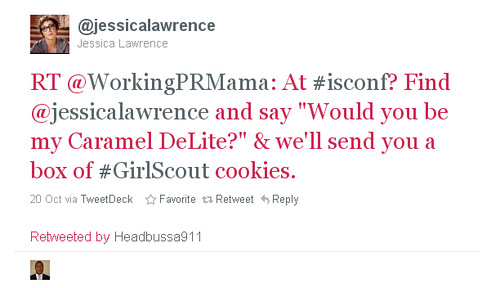
Last week, I had the pleasure of facilitating a Networked Nonprofit and Social Media workshop at the Independent Sector Annual Conference “Forging A Stronger Future Together” in Atlanta. As part of my role as Visiting Scholar at the Packard Foundation, I had an opportunity to coach Independent Sector on their conference social media integration.
Most participants included CEOs of nonprofit institutions and foundations and have been working in the sector for decades. The group also included a couple of “next gen” leaders as well as some experienced social media users in the nonprofit and foundation areas.
Technology Changes, People Don’t

Back in 1994, a software program called Word Perfect (circa 1994) was making the move from its DOS interface to its Windows GUI. A very large number of their longtime users stayed with DOS. As an early adopter, I remember switching, despite how strange it felt. Yet, at the time, people were questioning “How could serious work ever be done using a pull down menus?”
There was a revolt that included buttons that said “I’m sticking with DOS.” It is not uncommon that when a new technology emerges that has the potential to replace or improve upon an existing technology, people resist. There are people or even organizational cultures comfortable with using the existing tools and are slow to change, while early adopters and agile cultures keep learning and moving. In many cases, the slow to change eventually adopt or they no longer remain relevant to their constituents, donors, or loose their edge.
I think we’ve reached this juncture with social media in the nonprofit sector where it is time to adopt. Over the five years since I’ve been doing workshops on Social Media, there has definitely been an attitude shift from nonprofit leaders. I’m hearing less and less that using social networks is a waste of time or away to NGTD (Not Getting Things Done) and more “How do we get started strategically that right for our organizational culture, audience, and objectives.”
The first half of the workshop focused on the “Becoming A Networked Nonprofit” and we took a deep dive into social culture, transparency, and simplicity. The second half of the workshop looks at social media strategy and tactics. A couple of observations about themes that resonated:
- Joyful Funerals: This is a term I first heard from MomsRising about how they give themselves permission to fail and stop doing something that doesn’t work with social media. And, that through this comes learning and insight.
- Silo Busting: Ironically, I had two people in the workshop who worked for the same organization, but had not met each other! There was an excellent discussion about silo busting techniques and the role of leaders in bringing down the cubicle walls.
- Small Incremental Steps: There was a collective sign of relief when many heard me say – “You don’t have to do it all.” I firmly believe in incremental steps when moving into social media, especially if that is the best match for an organization’s culture.
While the workshop was described a basic introduction, we did have a small number of participants with a lot of social media experience including Jessica Lawrence, the CEO of the Gorgonio Girls Scout Council, Michael Smith, Case Foundation, and Jennifer Bahaus, High Museum of Art. The conversations that begin with “We did this and this is what we found …” can always enrich a workshop.

I learned that CEO of local Girls Scout Council, Jessica Lawrence was using Twitter as a clever networking tool. Her marketing staff person was tweeting, using the conference tag #ISCONF and offered anyone a free box of cookies if they found at the conference and asked, “Would you be my Caramel Delite?” She had a number of people approach her!
I didn’t get a chance to attend many sessions because I was in Atlanta a short-term, but I am grateful for the wiki journal report by Kathy Reich from the Packard Foundation her key takeaways. The Packard Foundation OE wiki is a pilot project aimed at providing an easy way for the OE team to share their thinking and resources with partners – a sort of “see through” filing cabinet.
Earlier in the morning, I had the opportunity to do a remote keynote about the Networked Nonprofit with Allison Fine at the BlackBaud Conference. Allison was in the room, but I was in my hotel room in Atlanta in my PJs! A previously recorded video was presented and I participated in the backchannel Twitter stream while Allison delivered the keynote.
I’ve been finding RowFeeder useful to do a quick and dirty content analysis and grab all the tweets into a google spreadsheet. The content analysis gives you some insights into what lines were Tweeted most. Interesting to discover a line from the book, “Social Media is a contact sport, not a spectator sport” was a conversation driver.
If you were not able to attend, there is terrific coverage of the event. Take for example this post from Rosita Cortez pointing to five videos of presentations. Frank Barry organized a series of Ignite presentations about social media and Nonprofits. The presenters included Geoff Livingston, my business partner at Zoetica as well as Claire Williams Diaz, Social Innovation at Twitter; Noah Everett, Founder of TwitPic; Matthew Mahan, Vice President of Impact at Causes; and Ramya Raghavan, Nonprofit and Activism, Manager at YouTube.
The downside to virtual presenting is that you don’t get to see your friends face-to-face!
